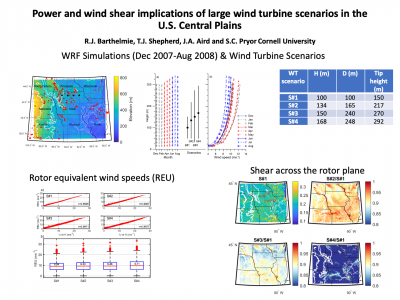Reaching-Up to Power-Up
Until recently, the assumption was that most/all of the swept area of wind turbine rotors fell within the surface layer (the lowest ~10% of the atmospheric boundary layer) and thus, similarity theory could be invoked to describe the height dependence of wind speeds. However, as rotor tip heights have extended beyond 100 m height, surface layer theory is no longer necessarily applicable and more complex formulations of the wind speed variation with height may be needed and other phenomena become relevant to wind resources and wind loading.
High-resolution simulations with the Weather Research and Forecasting model are used to generate statistics of wind speed, power, and shear across the rotor plane. Increasing wind turbine dimensions from current values (approximately H = 100 m, D = 100 m) to those of the new International Energy Agency reference wind turbine (H = 150 m, D = 240 m), the harnessable power across the rotor plane increases 7.1 times. The wind shear exponent (α) across the rotor plane is a source of blade bending moment and fatigue loading. It decreases from 0.21 (H = 100 m, D = 100 m) to 0.19 for the largest wind turbine scenario considered (H = 168 m, D = 248 m) and the frequency of extreme positive shear (α > 0.2) declines from 48% to 38% of 10-min periods. Thus, the deployment of larger wind turbines potentially yields considerable net benefits for both the wind resource and reductions in fatigue loading related to vertical shear.
Increases in wind turbine dimensions are being driven in part by the desire to harness higher wind speeds aloft (increasing hub-heights) and to increase the rotor-swept area (via increased rotor diameters). Concerns have been voiced that extending higher in the atmosphere might lead to increased wind loading and reduced wind turbine lifetimes. This research shows that this penalty is not realized over Iowa.
Economies of scale and reductions in the levelized cost of energy from wind turbines are driving the wind energy industry towards larger wind turbines. This research show that in the absence of other constraints the upscaling will lead tremendous benefits in terms of power production and has the co-benefit of reduce wind-induced fatigue loading on the structures.

